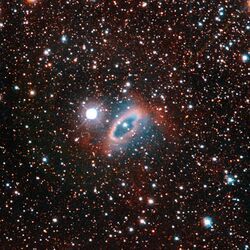Astronomy:SuWt 2
From HandWiki
Short description: Planetary nebula
| Emission nebula | |
|---|---|
| Planetary nebula | |
 Image of SuWt 2 taken from the Cerro Tololo Inter-American Observatory. | |
| Observation data: J2000 epoch | |
| Right ascension | 13h 55m 43.23s |
| Declination | −59° 22′ 40.03″[1] |
| Distance | 6,500 ly |
| Apparent magnitude (V) | 11.52[1] |
| Constellation | Centaurus |
| Designations | PN G311.0+02.4, DENIS J135543.2-592239, GSC 08676-01161, 2MASS J13554323-5922398, PK 311+02 2[1] |
Coordinates: ![]() 13h 55m 43.23s, −59° 22′ 40.03″
13h 55m 43.23s, −59° 22′ 40.03″
SuWt 2 is a planetary nebula viewed almost edge-on[2] in the constellation of Centaurus. It is believed that high UV radiation from an undiscovered white dwarf ionizes this nebula. Currently, there is a binary system consisting of two A-type main-sequence stars whose radiation is not sufficient to photo-ionize the surrounding nebula.[3] The nebula is easily obscured by the brighter star, HD 121228.
It has been suggested that it has a triple stellar system. One of them, which is more massive than other two A-type main-sequence stars, evolved rapidly and became a red giant, swallowing the other two stars, and produced the planetary nebula.[2]
References
- ↑ 1.0 1.1 1.2 "PN SuWt 2". SIMBAD. Centre de données astronomiques de Strasbourg. http://simbad.u-strasbg.fr/simbad/sim-basic?Ident=PN+SuWt+2.
- ↑ 2.0 2.1 "White Dwarf Lost in Planetary Nebula". http://hubblesite.org/newscenter/archive/releases/2008/21/full/. Retrieved December 12, 2016.
- ↑ Danehkar, A.; Parker, Q. A.; Ercolano, B. (2013). "Observations and three-dimensional ionization structure of the planetary nebula SuWt 2". Mon. Not. R. Astron. Soc. 434 (2): 1513–1530. doi:10.1093/mnras/stt1116. Bibcode: 2013MNRAS.434.1513D.
 |

